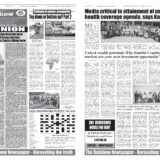Farming Season is here, what you plant matters
Notice: Undefined index: catFilterList in /home/zambi/public_html/wp-content/plugins/wp-likes/api.php on line 243

William Chilufya with Vice President Inonge Wina and Agriculture Minister Given Lubinda
By William Chilufya, Hivos Southern Africa
In the midst of a rising population, diminishing resources, a fluctuating economy and deteriorating environment, the fight to achieve household food and nutrition security is one of the greatest challenges facing Zambia.

William Chilufya with former Health Minister Dr Joseph Kasonde
It’s that time of the year when farmers are anxious about the rains as we get ready to plant. Decisions are being made on what needs to be planted, where to get the seeds, and other farming inputs.
Each farming season brings memories of my childhood, my time in Kalebwe village, Mukonchi area as an active village boy, when my grandfather would inform us about what sort of crops we were to grow that particular season. What I recall vividly is how he would explain the reasons for planting particular crops. For example he would say “this year we are going to grow some millet for sale to those that brew the local beer called ‘Katata’; ten acres of groundnuts will have to be planted for sale.” Maize always took up the greatest part of our fields. Similarly, we would sell some of it, and keep some for our nshima. I recall the many different crops that would be in one field – a maize field, for instance, also had sorghum, pumpkins, cow peas and Imisale (traditional sugar canes).
Sadly today, this traditional practise of growing a variety of crops, is diminishing and quickly being replaced by mono-cropping. Zambia’s dependency on maize is widespread, with 94 percent of agricultural fields being mono cropped, largely due to policies and systems in the agriculture and economic sectors that support the production, marketing and distribution of maize.
Undoubtedly, these figures are alarming and a threat to the health of Zambians. Mono-cropping is continuously eroding ecosystems, reducing crop diversity, depleting the soil and as a consequence, vastly limiting the diversity of foods in the country, which affects the stability in the supply of food to assure food security, and has an immense negative impact on the nutritional intake of citizens.
According to the National Food and Nutrition Commission (NFNC), one of the major causes of malnutrition is a mono diet. A Zambian diet typically consists of ‘Nshima’, Zambia’s dearest hard porridge prepared entirely with maize powder. About 15% of the under five children are underweight, 6% are wasted and 40% of the children under five years are stunted, indicating chronic malnutrition. On the other end of the spectrum, 23 percent of women in Zambia are considered overweight or obese; a situation which has brought complexities in the management of nutrition. Malnutrition in all its forms steals the productive capacities of people.
Growing a variety of crops has numerous advantages. Not only is it a way of ensuring diverse foods on the plate; it is also a method of insurance. After all, the farmer who grows a single crop runs the risk that climate or economic conditions in a particular year might not be appropriate for it. Take for instance the maize floor price that is hardly constant; diversification in this instance helps to cushion financial impact for the farmer.
Summarizing, the more different crops the farmer grows, the lower the risk of income loss, since at least some of his/her crops are likely to tolerate the weather conditions, the floor price in certain instances or a pest outbreak.
Traditionally, planting large numbers of different crops was not done at random. Particular combinations of crops were desirable for different reasons. In a well-organized intercropping system, early established plants will reduce soil temperature and produce the appropriate micro-climate for other plants. Maize and sorghum for instance can advantageously be grown together with legumes such as cow peas and rye grass.

William Chilufya with children
By growing a vast mix of crops, one increases the total biomass. Hence, the amount of organic matter that can be returned to the soil or fed to animals whose dung is then removed for manure.
Farmers produce the foods and ingredients that form the basis of the quantity and diversity of foods available for human consumption. What and how food is produced has a vital significance and impact on diet diversity and quality, which is a key issue Hivos Southern Africa and the International Institute for Environment and Development (IIED) are championing. In Zambia, Hivos and IIED focus their efforts to advocate for more sustainable, diverse, healthy and nutritious food, available for all citizens, including low income families.

William Chilufya with Vice President Inonge
Hivos and IIED believe that diversity of production is one key element in the agricultural production subsystem; it is highly important for a quality national diet. This entails moving away from the sole production of staple crops such as maize and starchy roots. There is evidence that increasing on-farm diversity can have a strong impact on dietary diversity among subsistence oriented producer households too. Therefore, as you make those final decisions on what to plant, please remember that we need diverse production to arrive at diverse and healthy consumption.
The author is the Regional Advocacy Manager for Sustainable Foods at Hivos Southern Africa























